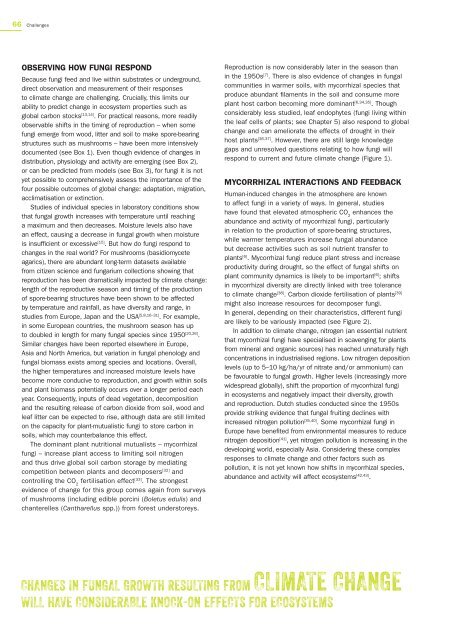gom1
Create successful ePaper yourself
Turn your PDF publications into a flip-book with our unique Google optimized e-Paper software.
66 Challenges<br />
OBSERVING HOW FUNGI RESPOND<br />
Because fungi feed and live within substrates or underground,<br />
direct observation and measurement of their responses<br />
to climate change are challenging. Crucially, this limits our<br />
ability to predict change in ecosystem properties such as<br />
global carbon stocks [13,14] . For practical reasons, more readily<br />
observable shifts in the timing of reproduction – when some<br />
fungi emerge from wood, litter and soil to make spore-bearing<br />
structures such as mushrooms – have been more intensively<br />
documented (see Box 1). Even though evidence of changes in<br />
distribution, physiology and activity are emerging (see Box 2),<br />
or can be predicted from models (see Box 3), for fungi it is not<br />
yet possible to comprehensively assess the importance of the<br />
four possible outcomes of global change: adaptation, migration,<br />
acclimatisation or extinction.<br />
Studies of individual species in laboratory conditions show<br />
that fungal growth increases with temperature until reaching<br />
a maximum and then decreases. Moisture levels also have<br />
an effect, causing a decrease in fungal growth when moisture<br />
is insufficient or excessive [15] . But how do fungi respond to<br />
changes in the real world? For mushrooms (basidiomycete<br />
agarics), there are abundant long-term datasets available<br />
from citizen science and fungarium collections showing that<br />
reproduction has been dramatically impacted by climate change:<br />
length of the reproductive season and timing of the production<br />
of spore-bearing structures have been shown to be affected<br />
by temperature and rainfall, as have diversity and range, in<br />
studies from Europe, Japan and the USA [5,8,16–31] . For example,<br />
in some European countries, the mushroom season has up<br />
to doubled in length for many fungal species since 1950 [20,26] .<br />
Similar changes have been reported elsewhere in Europe,<br />
Asia and North America, but variation in fungal phenology and<br />
fungal biomass exists among species and locations. Overall,<br />
the higher temperatures and increased moisture levels have<br />
become more conducive to reproduction, and growth within soils<br />
and plant biomass potentially occurs over a longer period each<br />
year. Consequently, inputs of dead vegetation, decomposition<br />
and the resulting release of carbon dioxide from soil, wood and<br />
leaf litter can be expected to rise, although data are still limited<br />
on the capacity for plant-mutualistic fungi to store carbon in<br />
soils, which may counterbalance this effect.<br />
The dominant plant nutritional mutualists – mycorrhizal<br />
fungi – increase plant access to limiting soil nitrogen<br />
and thus drive global soil carbon storage by mediating<br />
competition between plants and decomposers [32] and<br />
controlling the CO 2<br />
fertilisation effect [33] . The strongest<br />
evidence of change for this group comes again from surveys<br />
of mushrooms (including edible porcini (Boletus edulis) and<br />
chanterelles (Cantharellus spp.)) from forest understoreys.<br />
Reproduction is now considerably later in the season than<br />
in the 1950s [7] . There is also evidence of changes in fungal<br />
communities in warmer soils, with mycorrhizal species that<br />
produce abundant filaments in the soil and consume more<br />
plant host carbon becoming more dominant [6,34,35] . Though<br />
considerably less studied, leaf endophytes (fungi living within<br />
the leaf cells of plants; see Chapter 5) also respond to global<br />
change and can ameliorate the effects of drought in their<br />
host plants [36,37] . However, there are still large knowledge<br />
gaps and unresolved questions relating to how fungi will<br />
respond to current and future climate change (Figure 1).<br />
MYCORRHIZAL INTERACTIONS AND FEEDBACK<br />
Human-induced changes in the atmosphere are known<br />
to affect fungi in a variety of ways. In general, studies<br />
have found that elevated atmospheric CO 2<br />
enhances the<br />
abundance and activity of mycorrhizal fungi, particularly<br />
in relation to the production of spore-bearing structures,<br />
while warmer temperatures increase fungal abundance<br />
but decrease activities such as soil nutrient transfer to<br />
plants [6] . Mycorrhizal fungi reduce plant stress and increase<br />
productivity during drought, so the effect of fungal shifts on<br />
plant community dynamics is likely to be important [6] ; shifts<br />
in mycorrhizal diversity are directly linked with tree tolerance<br />
to climate change [38] . Carbon dioxide fertilisation of plants [39]<br />
might also increase resources for decomposer fungi.<br />
In general, depending on their characteristics, different fungi<br />
are likely to be variously impacted (see Figure 2).<br />
In addition to climate change, nitrogen (an essential nutrient<br />
that mycorrhizal fungi have specialised in scavenging for plants<br />
from mineral and organic sources) has reached unnaturally high<br />
concentrations in industrialised regions. Low nitrogen deposition<br />
levels (up to 5–10 kg/ha/yr of nitrate and/or ammonium) can<br />
be favourable to fungal growth. Higher levels (increasingly more<br />
widespread globally), shift the proportion of mycorrhizal fungi<br />
in ecosystems and negatively impact their diversity, growth<br />
and reproduction. Dutch studies conducted since the 1950s<br />
provide striking evidence that fungal fruiting declines with<br />
increased nitrogen pollution [35,40] . Some mycorrhizal fungi in<br />
Europe have benefited from environmental measures to reduce<br />
nitrogen deposition [41] , yet nitrogen pollution is increasing in the<br />
developing world, especially Asia. Considering these complex<br />
responses to climate change and other factors such as<br />
pollution, it is not yet known how shifts in mycorrhizal species,<br />
abundance and activity will affect ecosystems [42,43] .<br />
CHANGES IN FUNGAL GROWTH RESULTING FROM CLIMATE CHANGE<br />
WILL HAVE CONSIDERABLE KNOCK-ON EFFECTS FOR ECOSYSTEMS

















